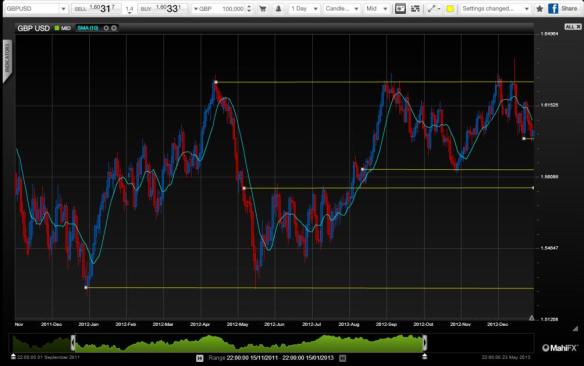
Overview
In the last fortnight we’ve seen a cacophony of developments: continued dovish central bank policies, negative rates in the Eurozone, a downward World Bank revision on world growth forecasts (from 3.2% to 2.8% for the 2014), fears of emerging market financial crisis, a top Republican in the U.S. losing his primary re-election, oil price spikes, and of course, terrorists on a rampage in Iraq again. Currently, the mood is one of caution rather than outright fear, but the indicators are getting louder. This should all be very bullish for the safe havens; that’s, if times were ‘normal’, and rates were rising. But these aren’t ‘normal times’.
USA
Fundamentals are taking a back seat to other developments. The situation in Iraq is unsettling for the U.S., and is being reflected in oil prices. Even though the broader financial market mood is cautious, the U.S. dollar benefits from its safe haven status. With the Fed inching toward policy normalization, U.S. bond rates are likely to move up. If it happens, expect a significant decoupling between the USD vs. most major currencies. Why “if it happens”? Because the International Monetary Fund on Monday cut its growth forecast for the U.S. economy and said that the Federal Reserve may have scope to keep interest rates at zero for longer than investors expect.
If Iraq implodes, expect USD strength; and when the crisis subsides, the USD should continue its recent slip against commodity currencies.
Russia / Emerging Markets
In spite of an armored Russian column crossing the border into eastern Ukraine according to Ukraine’s interior minister, market concerns seemed to have eased. Implied volatility in the USD/RUB is off 1.5% to 8.15%. Perhaps, Russian involvement in Ukraine is gradually being accepted, or at a minimum condoned. G7 countries did not adopt specific sanctions against Russia if it continues to interfere in Ukraine, and Putin was even in attendance at D-Day commemoration ceremonies.
Geopolitical and market concerns have shifted to Iraq, where Islamists have captured city after city. Russia by the way has stepped in with a familiar refrain: “We told you so.” Russian Foreign Minister Sergei Lavrov said “We warned long ago that the affair that the Americans and the Britons stirred up there wouldn’t end well. “
- Russia’s central bank kept the policy rate unchanged at 7.50%
Oil extended gains on speculation that an escalation of violence in Iraq would threaten output from OPEC’s second-biggest crude producer. Will increased volatility in oil prices spill over into higher volatility the FX markets? So far, actual volatility has increased, but implied volatilities haven’t for Turkish lira (TRY) and the Israeli Shekel (ILS), which are the only two currencies in the region in which I’d considering holding positions. Although both currencies are at multi – month lows vs. the USD, their 1-month at-the-money implied volatilities vs. USD are 10.36% and 4.28%, respectively. This is slightly lower than their 1-year historic levels. But that said, if the insurgents continue to stir things up, expect much higher implied volatility and historic volatilities for both.
China
Some good data interspersed within the negative have provided hope that the trend is improving. Among the positive pieces of news were strong production figures, which bolstered confidence that the so-called mini-stimulus woiuld prevent a deeper economic slowdown. Data confirms stabilization of activity and even a modest improvement on the manufacturing side. May industrial output matched the median estimate in a Bloomberg News survey. Ministry of Finance data released showed May fiscal expenditure rose. In the words of the Ministry of Finance “We have great evidence that infrastructure projects have increased.” I just love the phase from a government official that, “ We have great evidence.” Just imagine Obama saying that without the data to support it.
Expect further central bank easing in the months to come. The Peoples’ Bank of China released its 2014 outlook and promised continued “fine-tuning” of policy to achieve goals like liberalization of interest rates, and it also promised that it would research deposit insurance. The central bank has strengthened the daily reference rate against the dollar by 0.2 %; the biggest weekly advance this year. Peoples’ Bank of China cut its reserve requirements for rural banks became effective today, June 16th.
Euro (EUR)
The ECB cut deposits rates down into negative territory, maintained their dovish tone, and announced a series of measures to encourage bank lending.
Note: The ECB didn’t announce QE in any form.
Last week taxi drivers illustrated just how difficult any structural reform in Europe would be. A U.S. company named Uber allows passengers to use cellphones to call up independent car services and book rides. Basically, it’s a match.com for people looking for rides. Taxi-drivers protested in Berlin, Paris, London and Madrid. They say Uber is not fair because the car services don’t have the same regulatory costs, knowledge, and training as taxi drivers. Everyone calls for structural reform, fewer government regulations, and smaller government bureaucracies, but somehow everyone doesn’t really want it. This is a clash of new-tech vs. established method. It’s a small moment of truth with all the factors that need to be in the larger debate.
As dust continues to settle from the ECB’s efforts to boost inflation and growth, the EUR now acts as a funding currency. Interest rate differentials between the EUR and its major counterparties are now noticeable and resulting in downward pressure for the single currency. In medium term for USD to appreciate against the EUR, the U.S. economy needs to show growth, but in the case of the GBP, evidence of economic strength is apparent, and it will serve to strengthen the GBP/EUR. Technicals point to short term EUR strength vs. USD.
France
France recommended banks stop using the dollar for international transactions as BNP faces a $10 billion fine from the US for trading with forbidden counterparties (mostly Iran).
France unveiled part of a new budget that will cut €4 billion in public spending and €1.1 billion in household taxes.
Australian dollar (AUD)
The Australian dollar exceeded my favorable outlook. It approached the year’s high set in April. Monetary conditions in Australia are set to remain accommodative in the coming months. The benchmark cash target rate is likely to be kept unchanged at 2.50%. Consumer price inflation has continued to pick up gradually; price gains reached 2.9% y/y in the first quarter of 2014 compared with a 2.7% advance at the end of 2013. Note of caution – naming Australia, the IMF issued a dire warning about a global housing bubble, saying house prices are over the historical average vis-a-vis incomes and rents. Weakness in employment growth has pushed the employment to population ratio to 60.8%, near record lows. Expect the AUD to stand its ground in longer term, if not slip a little first, on some near term jawboning from the RBA.
Great British Pound (GBP)
In a speech the Canadian BoE Governor Carney warned that rates in the UK could rise sooner rather than later. He said that the UK economy is recovering a fast pace, and there are risks that labor market slack will be eroded faster than expected. His suggestion means that the BoE will be the first major central bank to normalize monetary policy since the global melt down. The divergent policies between the ECB and the BoE have pushed Yields between British and German 10-year government bonds to their widest since 1997. Expect continued GBP strength vs. its European counterpart. The GBP continued its bullish run nearing a 5 year high against the USD.
In what can be described as micromanaging of the good sort, the BoE will regulate banks to ensure mortgages are commensurate with incomes and property values, and the UK will also open old industrial sites for housing. They’re working hard to prevent a housing bust.
Canadian Dollar (CAD)
The CAD hasn’t benefitted from the rise in oil and gas prices stemming from the fresh Iraqi conflict. Safety concerns have dominated USD/CAD trading. Long term Iraqi oil supply interruptions will benefit the Loonie as Canada’s most lucrative export becomes more valuable. Like Australia, the IMF issued a dire warning about a Canadian’ housing bubble, saying house prices are over the historical average vis-a-vis incomes and rents. Foreign investors support Canada assets prices; they made the biggest purchase of Canadian securities in a year in April, buying stocks and selling government debt for an eighth straight month. External geopolitical risks increase CAD downside.
Japanese Yen (JPY)
Bolstered by the appeal of haven assets, the yen has risen against other majors reaching its strongest level in 4 months against the Euro.
Japanese monetary authorities reiterated that current easing is having the intended effect, and suggested that there is no need for more adjustment. Japan’s Government Pension Investment Fund (GPIF) will likely raise the amount allocated out of Japanese Government Bond Futures from 60% to 40% and into domestic equities, foreign bonds and foreign stocks by 5% each. Although technicals are neutral for the yen, the currency is trading outside the parameters of fundamentals and technicals. Risk aversion supports its recent strength. USD/JPY implied volatility is firm, while EUR/JPY implied volatility is off 1.0%.
Mexican Peso (MXN)
Geo-political risk aversion and a surprise Bank of Mexico overnight rate cut of 50 bp cut to 3.00% spurred a quick drop in the peso and then a strong recovery. Technically, the USD/MXN is poised to gain moderately in the coming days. The 13.00 level is just over the 55-day moving average.
This post was originally published on Hedgethink.com, a digital thought leadership platform focused on the alternative investment industry. See its full range of daily content here.
Tradersdna is a leading digital and social media platform for traders and investors. Tradersdna offers premiere resources for trading and investing education, digital resources for personal finance, market analysis and free trading guides. More about TradersDNA Features: What Does It Take to Become an Aggressive Trader? | Everything You Need to Know About White Label Trading Software | Advantages of Automated Forex Trading


































